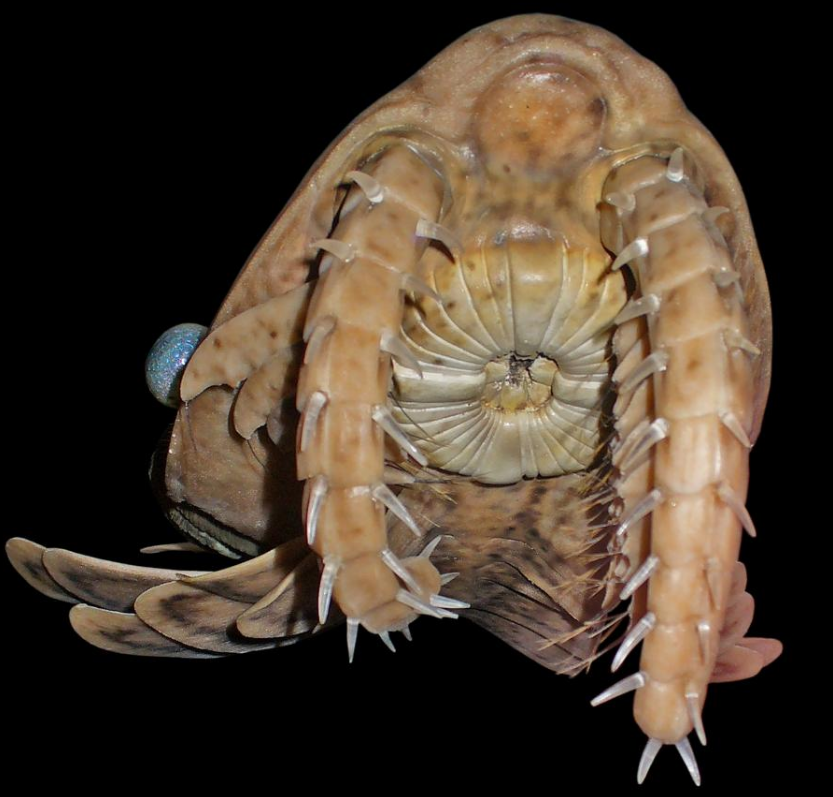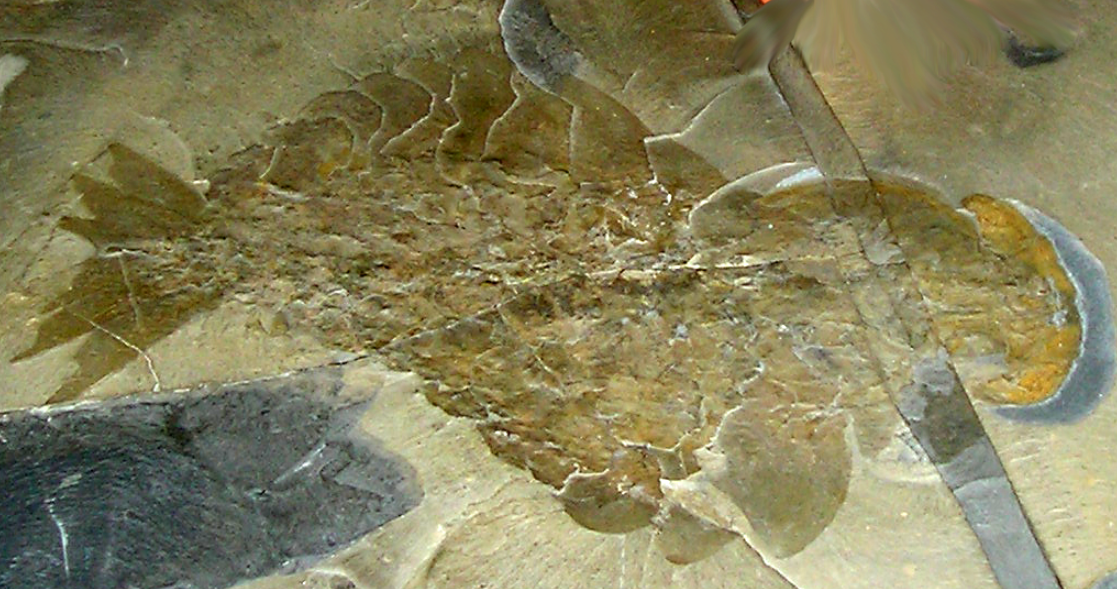
Video Upload Options
The Anomalocaridids comprise a group of very early marine animals known primarily from fossils found in Cambrian deposits in China , United States , Canada , Poland and Australia . They were long thought to be restricted to this Cambrian time range, but the discovery of large Ordovician specimens has extended this somewhat. The later Devonian Schinderhannes shows many anomalocaridid features. Although originally interpreted as an anomalocaridid-like arthropod, some recent studies suggest that it may represent an anomalocaridid: if so it would extend the group's record by some hundred million years: the non-mineralised anomalocaridid structure means they are absent from the intermediate fossil record. Anomalocaridids are the largest Cambrian animals known—some Chinese forms may have reached 2 m (7 ft) in length—and most of them were probably active carnivores.
1. Description
Anomalocaridids were flat, free-swimming, segmented animals that possessed two grasping appendages in front of their mouths (the "great appendages"). These consisted of a dozen or more jointed segments, which could be curled like fingers to grasp prey. Each segment bore a pair of spines, which were sometimes armed with smaller spinelets, that could be used to impale their food. The head was covered with a carapace formed by a series of chitinous plates, and the mouth was a circular structure resembling a pineapple slice, but with a ring of hard sharp teeth in the central orifice. The mouth was more rectangular than round, and the teeth did not meet in the middle. The skeletons of Anomalocaridids were sclerotized but not mineralized—the great appendages, head, and jaws had a tough chitin exoskeleton like an insect's, but not the hard, calcium carbonate skeleton seen in arthropods such as trilobites and crabs. Anomalocaridids also had large compound eyes,[1] a feature that they share with arthropods. The body was flanked with a series of flexible swimming lobes. On top of the back, there are a series of long, narrow, blade-shaped structures, which may have functioned as gills.

Anomalocaridids were not particularly large by modern standards, but during the Early Cambrian, they would have been among the largest creatures on Earth. Their raptorial great appendages and large, compound eyes suggest that they were apex predators, lying at the top of the Cambrian food chain. The sclerotized nature of the frontal appendages and jaws would have made them effective in piercing and shredding soft-bodied or tough prey items such as worms, primitive arthropods, and other anomalocaridids. However, the unmineralized skeleton would have made it difficult, although perhaps not impossible, to pierce the hard carapaces of animals like trilobites. Unlike their lobopod relatives, such as Kerygmachela, anomalocaridids lacked legs and were specialized for swimming. Anomalocaridids seem to have been swimming predators, similar to the fish and squid that would replace them in the Devonian. Compared with many of the other sea-dwelling creatures of their time, anomalocaridids must have been fast and agile. The flaps along its body could probably be moved in a wave-like formation, allowing it to swim quickly or to 'hover', as in Batoidea (rays) or cuttlefish.
After death this large organism tended to disintegrate and fall apart into separate pieces; the same happened to its moulted skins. Completely intact fossil remains are very rare. When the fossils were originally described, the jointed arms in front of the mouth were classified as separate arthropods (precipitating quite a mystery; the fossils were mistakenly identified as "shrimp", but always with their "heads" missing), the mouth was thought to have been a fossilized jellyfish called Peytoia, and the body, thought to be a sponge named "Laggania" was not associated with either. Since the pieces were reassembled in the 1980s, a number of genera and species have been described that differ in the details of the grasping appendages, as to whether a tail is present, mouth location, and other features. The name Anomalocaris (meaning "strange shrimp") originally referred to detached arms (which were the first part to be named) similar to those of Peytoia. Curiously enough, when fully assembled, these animals outwardly resemble gigantic brine shrimp with a pair of finger-like appendages near the mouth.
The anomalocaridids thrived in the Early and Mid-Cambrian, and are rarer in later deposits mainly due to the scarcity of post-Cambrian Lagerstätten. Nevertheless, they are still present in Ordovician Lagerstätten [2] and a few anomalocaridids were able to survive as late as the Devonian.
2. Classification

Five genera of anomalocaridids are known: Anomalocaris, Peytoia, Schinderhannes, Amplectobelua and Hurdia. A variety of other related animals including Parapeytoia, Pambdelurion and Kerygmachela have been classified as anomalocaridids, but recent studies suggest they belong to different clades. Anomalocaridids are quite common throughout the Cambrian, and are known from the earliest Burgess shale-type fauna, in the early Cambrian of Poland, predating the first appearance of trilobites.[3]
Compared with Anomalocaris species, Peytoia species lacked tail structures and had a considerably larger head with the eyes placed behind instead of in front of the mouth, which would have been disadvantagous for active hunting. Because of these characteristics, some scientists have described Peytoia as a cruising, plankton feeder.[4] Amplectobelua species, in contrast to Anomalocaris, were smaller and had a much wider body front with eyes placed lateral to the mouth.
The relationships of anomalocaridids continue to be debated. Most recent analyses suggest that anomalocaridids are stem arthropods, that is, they are closely related to living Arthropoda, but do not actually lie inside the group. Features shared with arthropods include a head carapace, appendages that are covered with jointed plates, and compound eyes. Opabinia, which has been considered a close relative of anomalocaridids, lacks plates on the head or appendages, however. If Opabinia is related to anomalocaridids, then these features may have evolved independently in anomalocaridids and arthropods. More recent analyses, however, suggest that Opabinia may represent a more primitive lineage,[5] in which case the arthropod-like features seen in the group may be homologous. The Devonian Schinderhannes is a particularly problematic animal. It has been interpreted as having an arthropod-like body carapace and anomalocaridid-like great appendages, suggesting that it is intermediate between the two groups.[5] However, more recent studies suggest that Schinderhannes may lie within the anomalocaridids, and represent a close relative of Peytoia and Hurdia.[6]
References
- Nature: "An eye-opening fossil" http://www.nature.com/news/an-eye-opening-fossil-1.9586
- Robert R. Gaines; Derek E.G. Briggs; Patrick J. Orr; Peter Van Roy (2012). "Preservation of giant anomalocaridids in silica-chlorite concretions from the Early Ordovician of Morocco" (Abstract). PALAIOS 27. doi:10.2110/palo.2011.p11-093r. Bibcode: 2012Palai..27..317G. http://palaios.ku.edu/27/5/gaines.pdf.
- Budd, Graham E.; Peel, John S. (1998). "A New Xenusiid Lobopod from the Early Cambrian Sirius Passet Fauna of North Greenland". Palaeontology 41: 1201–13. http://palaeontology.palass-pubs.org/pdf/Vol%2041/Pages%201201-1213.pdf. Retrieved June 26, 2013.
- Dzik, J. and Lendzion, K. 1988. The oldest arthropods of the East European Platform. Lethaia, 21, 29–38.
- Kühl, G.; Briggs, D. E. G.; Rust, J. (Feb 2009). "A Great-Appendage Arthropod with a Radial Mouth from the Lower Devonian Hunsrück Slate, Germany". Science 323 (5915): 771–3. doi:10.1126/science.1166586. ISSN 0036-8075. PMID 19197061. Bibcode: 2009Sci...323..771K. https://dx.doi.org/10.1126%2Fscience.1166586
- Legg, David A., et al. "Cambrian bivalved arthropod reveals origin of arthrodization." Proceedings of the Royal Society B: Biological Sciences 279.1748 (2012): 4699-4704.




